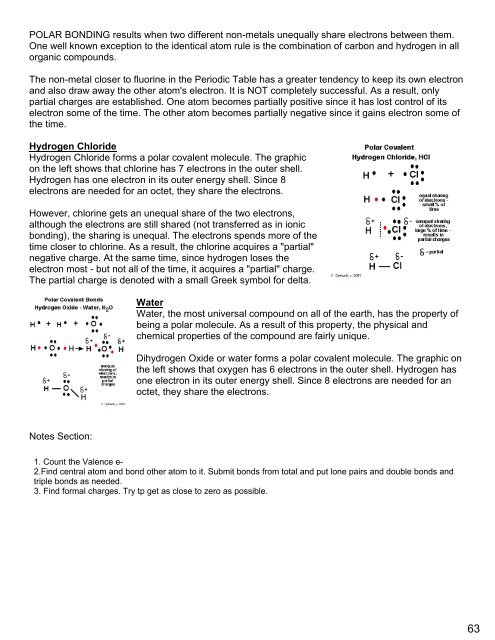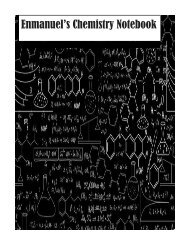Create successful ePaper yourself
Turn your PDF publications into a flip-book with our unique Google optimized e-Paper software.
POLAR BONDING results when two different non-metals unequally share electrons between them.<br />
One well known exception to the identical atom rule is the combination of carbon and hydrogen in all<br />
organic compounds.<br />
The non-metal closer to fluorine in the Periodic Table has a greater tendency to keep its own electron<br />
and also draw away the other atom's electron. It is NOT completely successful. As a result, only<br />
partial charges are established. One atom becomes partially positive since it has lost control of its<br />
electron some of the time. The other atom becomes partially negative since it gains electron some of<br />
the time.<br />
Hydrogen Chloride<br />
Hydrogen Chloride forms a polar covalent molecule. The graphic<br />
on the left shows that chlorine has 7 electrons in the outer shell.<br />
Hydrogen has one electron in its outer energy shell. Since 8<br />
electrons are needed for an octet, they share the electrons.<br />
However, chlorine gets an unequal share of the two electrons,<br />
although the electrons are still shared (not transferred as in ionic<br />
bonding), the sharing is unequal. The electrons spends more of the<br />
time closer to chlorine. As a result, the chlorine acquires a "partial"<br />
negative charge. At the same time, since hydrogen loses the<br />
electron most - but not all of the time, it acquires a "partial" charge.<br />
The partial charge is denoted with a small Greek symbol for delta.<br />
Water<br />
Water, the most universal compound on all of the earth, has the property of<br />
being a polar molecule. As a result of this property, the physical and<br />
chemical properties of the compound are fairly unique.<br />
Dihydrogen Oxide or water forms a polar covalent molecule. The graphic on<br />
the left shows that oxygen has 6 electrons in the outer shell. Hydrogen has<br />
one electron in its outer energy shell. Since 8 electrons are needed for an<br />
octet, they share the electrons.<br />
Notes Section:<br />
1. Count the Valence e-<br />
2.Find central atom and bond other atom to it. Submit bonds from total and put lone pairs and double bonds and<br />
triple bonds as needed.<br />
3. Find formal charges. Try tp get as close to zero as possible.




